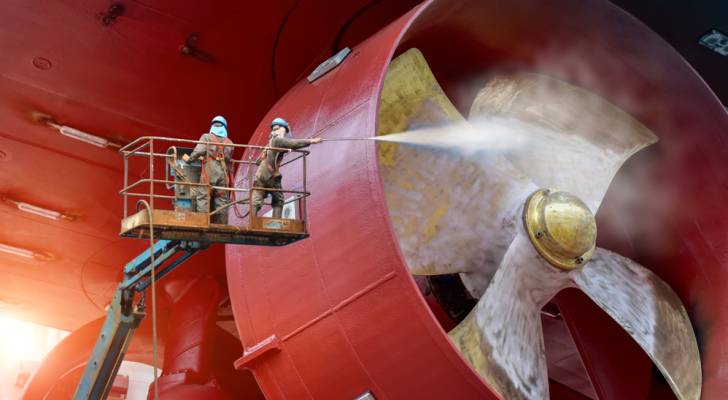
U.S. shipyards built thousands of cargo ships during World Wars I and II. In the 1970s, they built about 5-25 new ships per year. In the 1980s, this number fell to around 5 ships a year, and it has stayed there ever since, according to a 2023 Congressional Research Service report.
Don’t miss
- I’m 49 years old and have nothing saved for retirement — what should I do? Don’t panic. Here are 5 of the easiest ways you can catch up (and fast)
- Gain potential quarterly income through this $1B private real estate fund — even if you’re not a millionaire. Here’s how to get started with as little as $10
- Car insurance premiums could spike 8% by the end of 2025 — thanks to tariffs on car imports and auto parts from Canada and Mexico. But here’s how 2 minutes can save you hundreds of dollars right now
Meanwhile, China has rapidly grown its industry with government subsidies and state planning. It replaced South Korea to become the world’s leading shipbuilder in 2010, and currently builds hundreds of ships a year. Its market share went from less than 5% in 1999 to more than 50% in 2023, according to the U.S. Trade Representative (USTR), which said it was attained by unfair means and hurt American interests.
China’s largest state-owned shipbuilder built more commercial vessels by tonnage in 2024 than the entire U.S. shipbuilding industry has built since the end of World War II, according to a recent report from the Center for Strategic and International Studies.
The authors also highlighted the fact that this market dominance has been boosting the country’s navy. "Foreign companies are inadvertently helping to propel China’s naval buildup by buying Chinese-made ships and sharing dual-use technologies with Chinese shipyards," they wrote.
But President Donald Trump says it’s finally time to "resurrect" America’s shipbuilding sector – and investors are already placing their bets on one company poised to benefit significantly.
Trump’s promise
In a recent address, Trump signed a bold executive order aimed squarely at reviving American shipbuilding. Central to this strategy is the establishment of an Office of Shipbuilding in the White House, tasked with streamlining policy, cutting red tape, and revitalizing domestic maritime production. Special tax incentives will also be offered.
"We are also going to resurrect the American shipbuilding industry, including commercial shipbuilding and military shipbuilding," Trump said during his recent address to Congress. “We used to make so many ships. We don’t make them anymore very much, but we’re going to make them very fast, very soon, it will have a huge impact.”
Adding teeth to this ambitious strategy, the U.S. Trade Representative (USTR) proposed steep penalties – up to $1.5 million per vessel – on Chinese-built ships docking at American ports. Any shipping firm with at least one order on the books for a vessel made in China would also have to pay a fee. These fees would apply to 90% of the world’s vessels, according to the World Shipping Council.
However, after a backlash from various stakeholders, U.S. Trade Representative Jamieson Greer told lawmakers about the fees, "They’re not all going to be implemented. They’re not all going to be stacked."
The message is clear: Trump intends to challenge China’s maritime dominance head-on, part of a larger conflict centered on trade.
Skeptics of Trump’s plan suggest the available labor pool can’t address today’s demand – nevermind a new wave of building meant to counter China’s dominance. “We’re trying to get blood from a turnip,” Government Accountability Office analyst Shelby Oakley told ProPublica. “The domestic workforce is just not there.”
Read more: Want an extra $1,300,000 when you retire? Dave Ramsey says this 7-step plan ‘works every single time’ to kill debt, get rich in America — and that ‘anyone’ can do it
Investors eye a key stock
Investors, sensing the shift in tides, are eyeing one company in particular as a way to seize on the renewed focus on shipbuilding: Huntington Ingalls Industries (HII).
The Virginia-based shipbuilder is America’s largest military shipbuilding firm, renowned for constructing nuclear-powered aircraft carriers, submarines, and amphibious assault ships. HII is uniquely positioned to capitalize on Trump’s new maritime initiative.
Following Trump’s announcement, Huntington Ingalls Industries, which reported $11.5 billion in revenue in 2024, saw its stock surge significantly.
Investors have poured into HII, betting the company stands to gain tremendously from Trump’s shipbuilding push. HII stock is up 7% in the last month, reflecting growing investor enthusiasm and confidence in the company’s prospects. Goldman Sachs recently upgraded the stock from Sell to Buy and raised its price target from $145 to $234.
But challenges still loom large on the horizon.
Analysts caution that while Trump’s tariffs on Chinese vessels might seem like a decisive strike against foreign competition, they could inadvertently drive up shipping costs, impacting consumers through higher prices and potentially escalating trade tensions.
Meanwhile, rebuilding America’s shipyards and skilled workforce will require substantial, sustained investment beyond short-term policy shifts.
Despite these concerns, Trump remains bullish, and investors appear convinced that a revival is possible. Huntington Ingalls Industries stands ready to ride this wave of optimism and strategic backing.
Whether or not Trump’s ambitious vision for American shipbuilding ultimately succeeds remains uncertain. Yet, there’s renewed enthusiasm for the U.S. maritime industry – enough to spark investor enthusiasm and potentially shift the balance of maritime power back toward American shores.
What to read next
- Thanks to Jeff Bezos, you can now become a landlord for as little as $100 — and no, you don’t have to deal with tenants or fix freezers. Here’s how
- Here are 5 ‘must have’ items that Americans (almost) always overpay for — and very quickly regret. How many are hurting you?
- Trump warns his tariffs will spark a ‘disturbance’ in America — use this 1 dead-simple move to help shockproof your retirement plans ASAP
This article provides information only and should not be construed as advice. It is provided without warranty of any kind.


